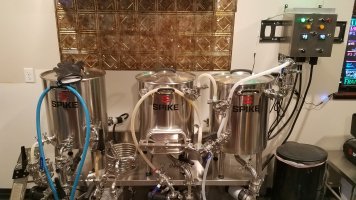couchsending
Well-Known Member
- Joined
- Jun 21, 2016
- Messages
- 3,063
- Reaction score
- 2,256
Forgive me if this has been addressed, maybe I didn't look hard enough.
About to pull the trigger on a 20g Spike Brewing Electric system. One question I have is the sparge/recirculation setup. To me it look like the Push To Connect fitting that comes with it could result in some serious channeling as it just spits the water out down the wall of the mash tun. Wouldn't you want to try to disperse the water more evenly/gently over the top of the grain bed? Has anyone used the SS Brewing sparge arm or recirc manifold instead? Or any other suggestions?
Thanks
About to pull the trigger on a 20g Spike Brewing Electric system. One question I have is the sparge/recirculation setup. To me it look like the Push To Connect fitting that comes with it could result in some serious channeling as it just spits the water out down the wall of the mash tun. Wouldn't you want to try to disperse the water more evenly/gently over the top of the grain bed? Has anyone used the SS Brewing sparge arm or recirc manifold instead? Or any other suggestions?
Thanks
























![Craft A Brew - Safale S-04 Dry Yeast - Fermentis - English Ale Dry Yeast - For English and American Ales and Hard Apple Ciders - Ingredients for Home Brewing - Beer Making Supplies - [1 Pack]](https://m.media-amazon.com/images/I/41fVGNh6JfL._SL500_.jpg)



































